2003 FORD F150 fuel pressure
[x] Cancel search: fuel pressurePage 3 of 72
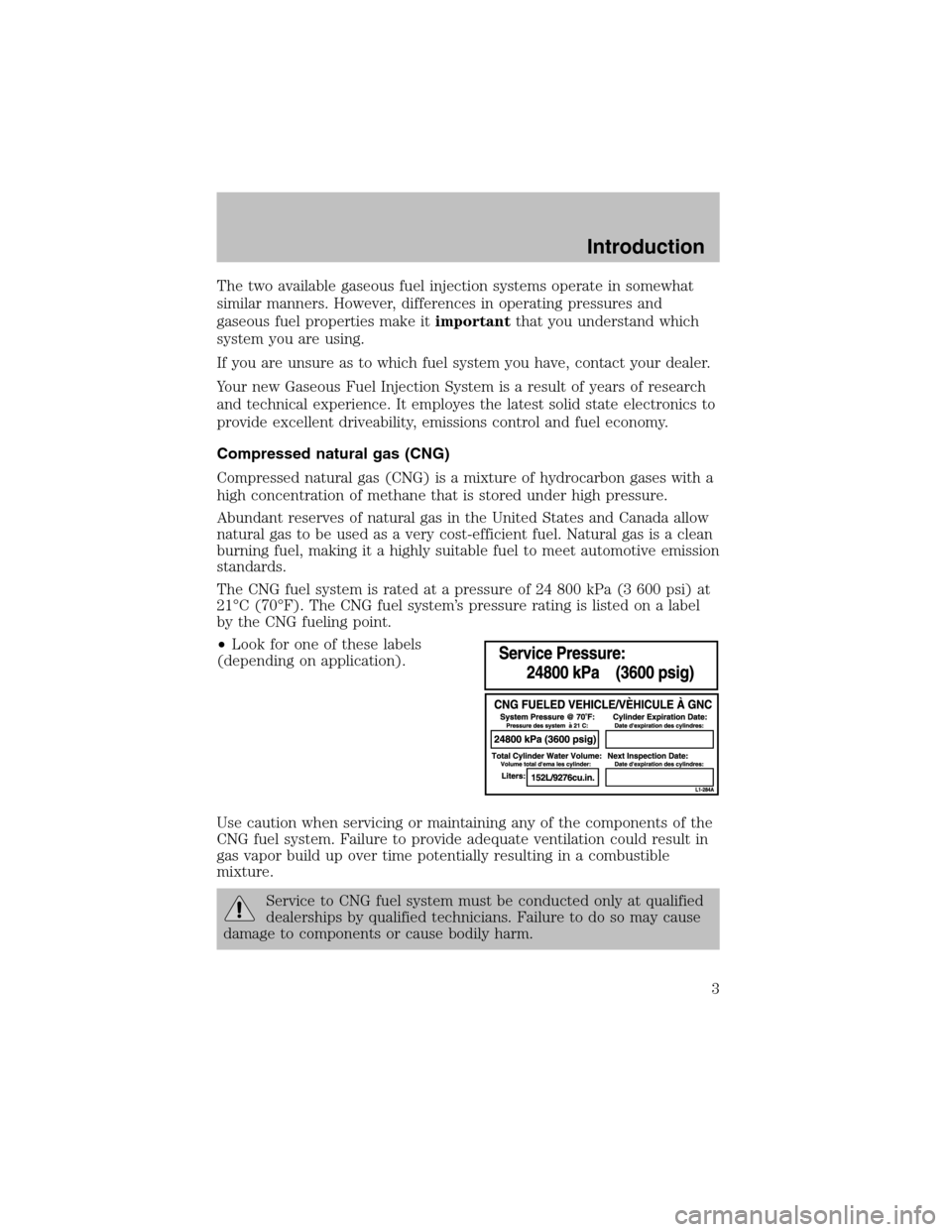
The two available gaseous fuel injection systems operate in somewhat
similar manners. However, differences in operating pressures and
gaseous fuel properties make itimportantthat you understand which
system you are using.
If you are unsure as to which fuel system you have, contact your dealer.
Your new Gaseous Fuel Injection System is a result of years of research
and technical experience. It employes the latest solid state electronicsto
provide excellent driveability, emissions control and fuel economy.
Compressed natural gas (CNG)
Compressed natural gas (CNG) is a mixture of hydrocarbon gases with a
high concentration of methane that is stored under high pressure.
Abundant reserves of natural gas in the United States and Canada allow
natural gas to be used as a very cost-efficient fuel. Natural gas is a clean
burning fuel, making it a highly suitable fuel to meet automotive emission
standards.
The CNG fuel system is rated at a pressure of 24 800 kPa (3 600 psi) at
21°C (70°F). The CNG fuel system’s pressure rating is listed on a label
by the CNG fueling point.
•Look for one of these labels
(depending on application).
Use caution when servicing or maintaining any of the components of the
CNG fuel system. Failure to provide adequate ventilation could result in
gas vapor build up over time potentially resulting in a combustible
mixture.
Service to CNG fuel system must be conducted only at qualified
dealerships by qualified technicians. Failure to do so may cause
damage to components or cause bodily harm.
Introduction
3
Page 4 of 72
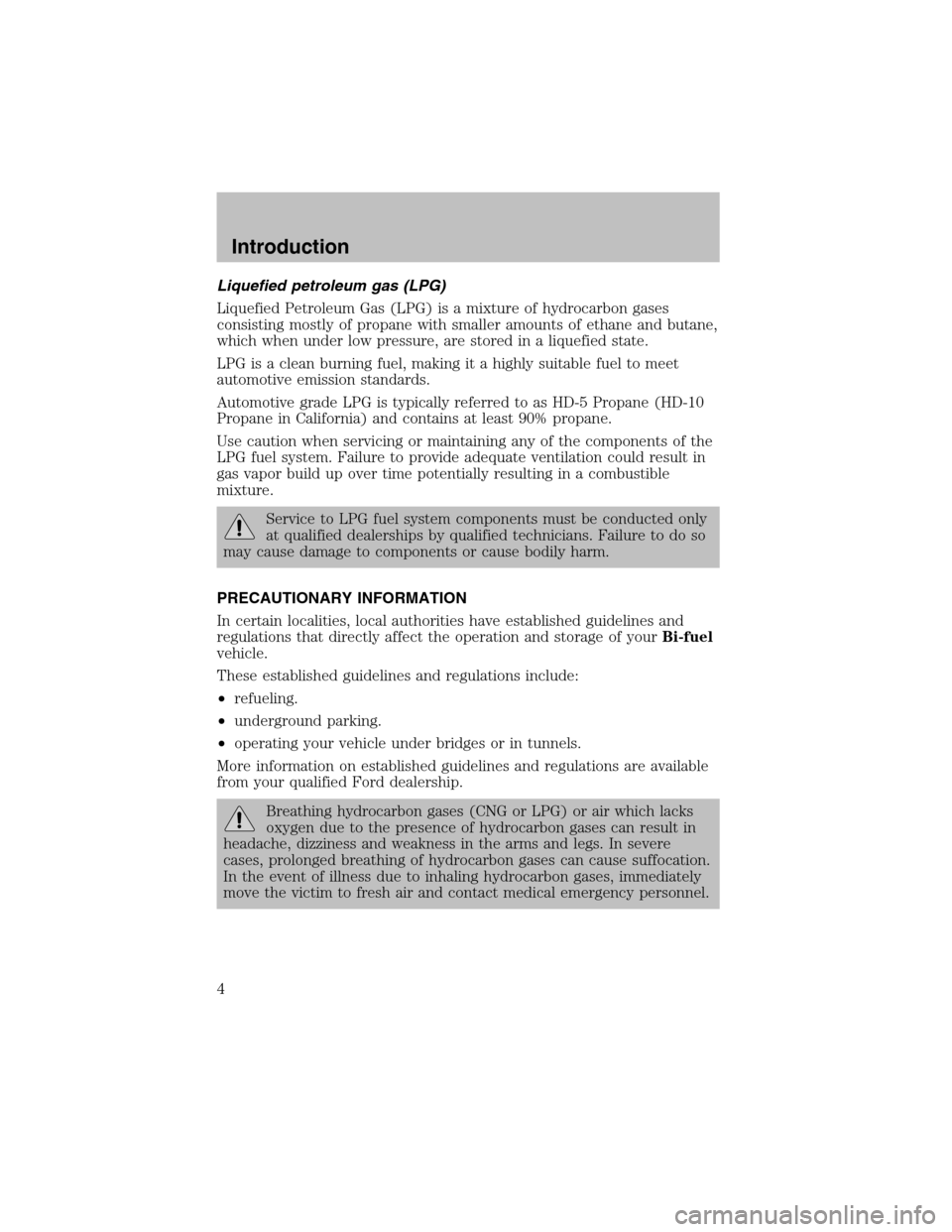
Liquefied petroleum gas (LPG)
Liquefied Petroleum Gas (LPG) is a mixture of hydrocarbon gases
consisting mostly of propane with smaller amounts of ethane and butane,
which when under low pressure, are stored in a liquefied state.
LPG is a clean burning fuel, making it a highly suitable fuel to meet
automotive emission standards.
Automotive grade LPG is typically referred to as HD-5 Propane (HD-10
Propane in California) and contains at least 90% propane.
Use caution when servicing or maintaining any of the components of the
LPG fuel system. Failure to provide adequate ventilation could result in
gas vapor build up over time potentially resulting in a combustible
mixture.
Service to LPG fuel system components must be conducted only
at qualified dealerships by qualified technicians. Failure to do so
may cause damage to components or cause bodily harm.
PRECAUTIONARY INFORMATION
In certain localities, local authorities have established guidelines and
regulations that directly affect the operation and storage of yourBi-fuel
vehicle.
These established guidelines and regulations include:
•refueling.
•underground parking.
•operating your vehicle under bridges or in tunnels.
More information on established guidelines and regulations are available
from your qualified Ford dealership.
Breathing hydrocarbon gases (CNG or LPG) or air which lacks
oxygen due to the presence of hydrocarbon gases can result in
headache, dizziness and weakness in the arms and legs. In severe
cases, prolonged breathing of hydrocarbon gases can cause suffocation.
In the event of illness due to inhaling hydrocarbon gases, immediately
move the victim to fresh air and contact medical emergency personnel.
Introduction
4
Page 5 of 72
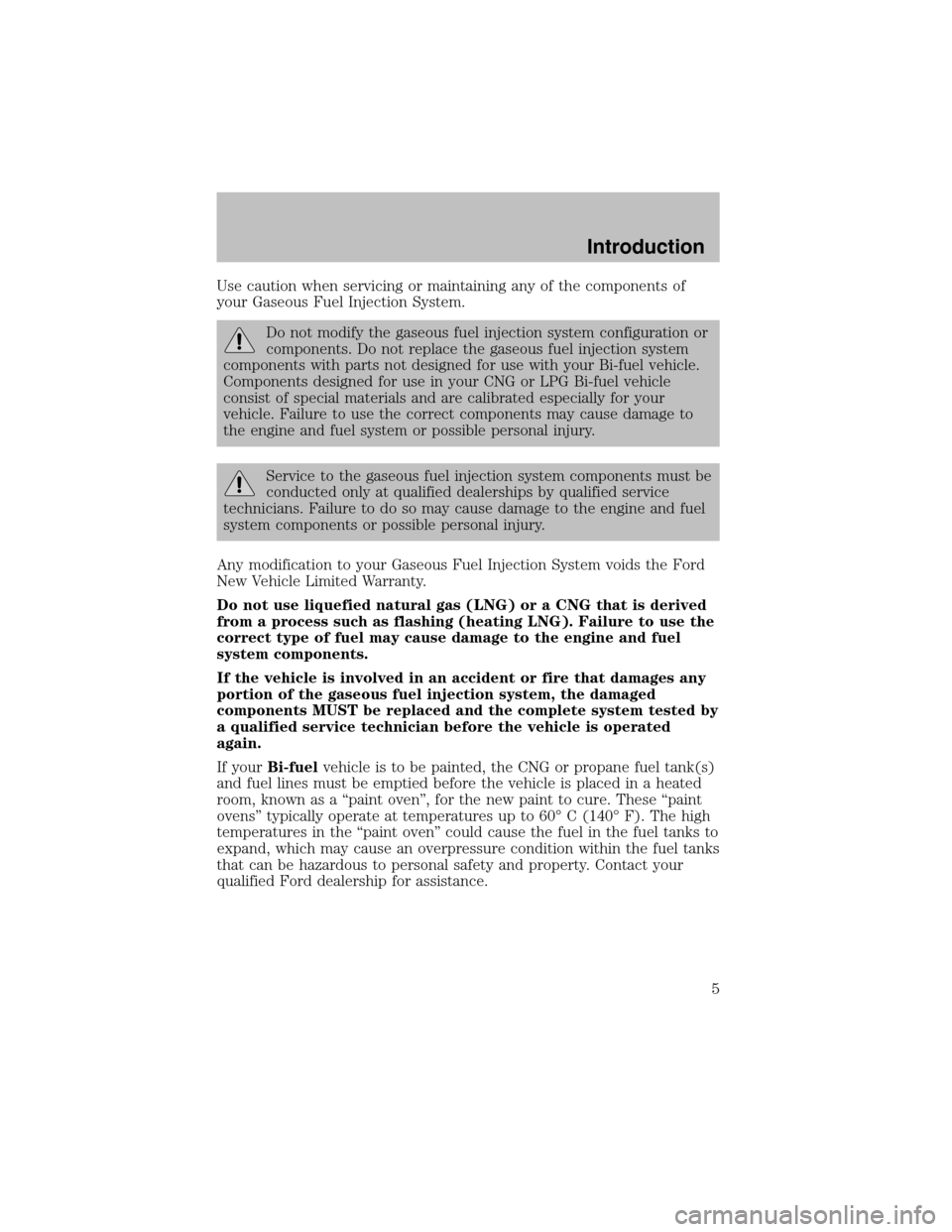
Use caution when servicing or maintaining any of the components of
your Gaseous Fuel Injection System.
Do not modify the gaseous fuel injection system configuration or
components. Do not replace the gaseous fuel injection system
components with parts not designed for use with your Bi-fuel vehicle.
Components designed for use in your CNG or LPG Bi-fuel vehicle
consist of special materials and are calibrated especially for your
vehicle. Failure to use the correct components may cause damage to
the engine and fuel system or possible personal injury.
Service to the gaseous fuel injection system components must be
conducted only at qualified dealerships by qualified service
technicians. Failure to do so may cause damage to the engine and fuel
system components or possible personal injury.
Any modification to your Gaseous Fuel Injection System voids the Ford
New Vehicle Limited Warranty.
Do not use liquefied natural gas (LNG) or a CNG that is derived
from a process such as flashing (heating LNG). Failure to use the
correct type of fuel may cause damage to the engine and fuel
system components.
If the vehicle is involved in an accident or fire that damages any
portion of the gaseous fuel injection system, the damaged
components MUST be replaced and the complete system tested by
a qualified service technician before the vehicle is operated
again.
If yourBi-fuelvehicle is to be painted, the CNG or propane fuel tank(s)
and fuel lines must be emptied before the vehicle is placed in a heated
room, known as a“paint oven”, for the new paint to cure. These“paint
ovens”typically operate at temperatures up to 60°C (140°F). The high
temperatures in the“paint oven”could cause the fuel in the fuel tanks to
expand, which may cause an overpressure condition within the fuel tanks
that can be hazardous to personal safety and property. Contact your
qualified Ford dealership for assistance.
Introduction
5
Page 6 of 72
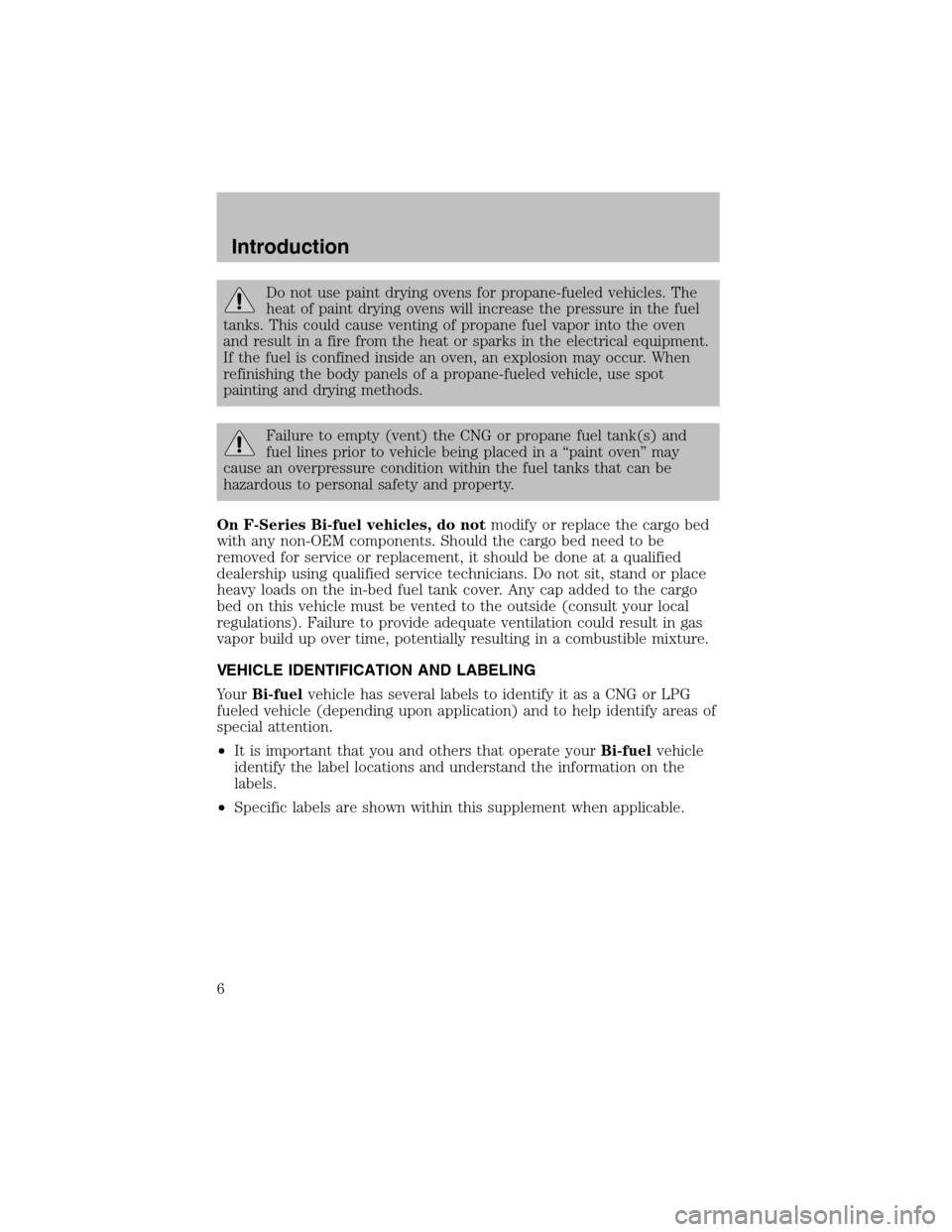
Do not use paint drying ovens for propane-fueled vehicles. The
heat of paint drying ovens will increase the pressure in the fuel
tanks. This could cause venting of propane fuel vapor into the oven
and result in a fire from the heat or sparks in the electrical equipment.
If the fuel is confined inside an oven, an explosion may occur. When
refinishing the body panels of a propane-fueled vehicle, use spot
painting and drying methods.
Failure to empty (vent) the CNG or propane fuel tank(s) and
fuel lines prior to vehicle being placed in a“paint oven”may
cause an overpressure condition within the fuel tanks that can be
hazardous to personal safety and property.
On F-Series Bi-fuel vehicles, do notmodify or replace the cargo bed
with any non-OEM components. Should the cargo bed need to be
removed for service or replacement, it should be done at a qualified
dealership using qualified service technicians. Do not sit, stand or place
heavy loads on the in-bed fuel tank cover. Any cap added to the cargo
bed on this vehicle must be vented to the outside (consult your local
regulations). Failure to provide adequate ventilation could result in gas
vapor build up over time, potentially resulting in a combustible mixture.
VEHICLE IDENTIFICATION AND LABELING
YourBi-fuelvehicle has several labels to identify it as a CNG or LPG
fueled vehicle (depending upon application) and to help identify areas of
special attention.
•It is important that you and others that operate yourBi-fuelvehicle
identify the label locations and understand the information on the
labels.
•Specific labels are shown within this supplement when applicable.
Introduction
6
Page 11 of 72
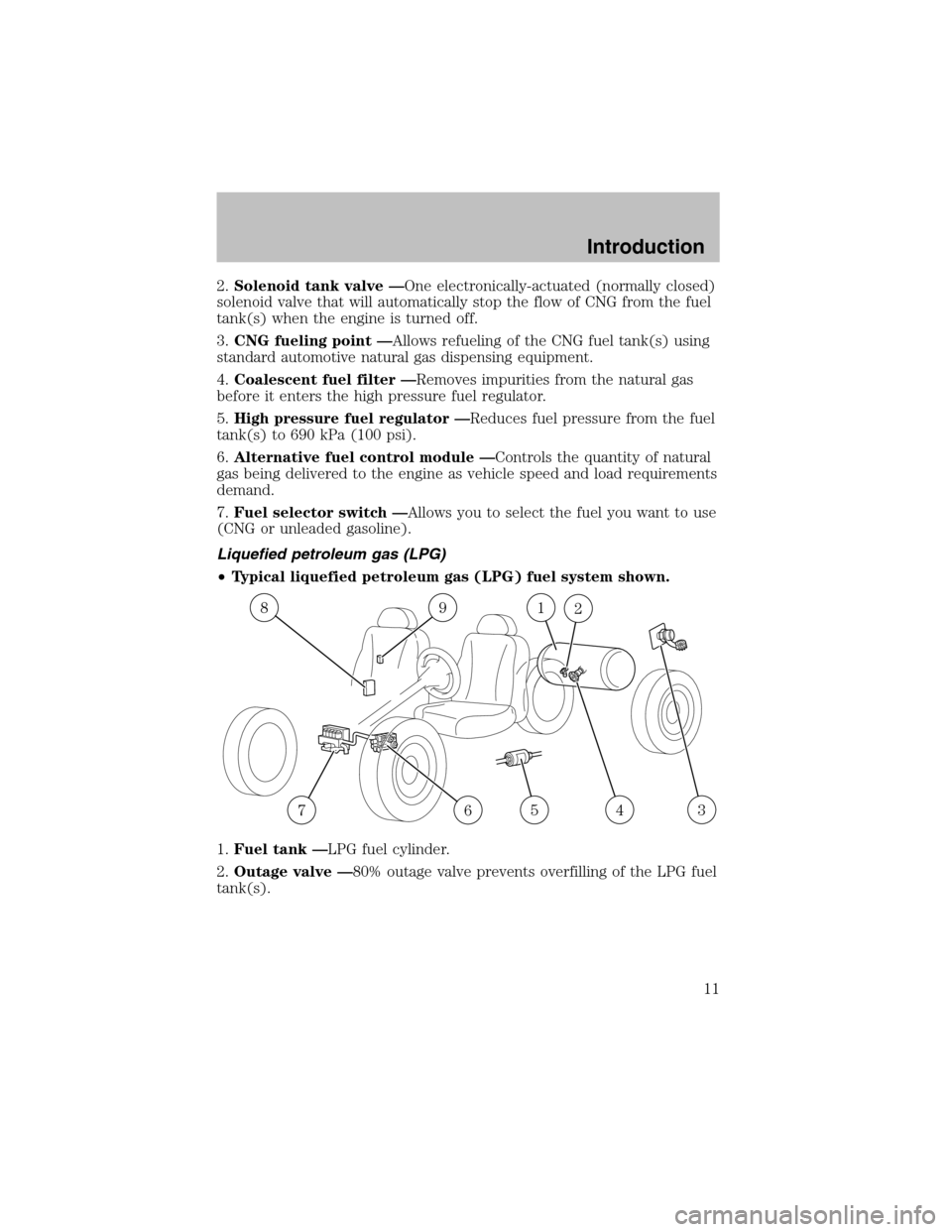
2.Solenoid tank valve—One electronically-actuated (normally closed)
solenoid valve that will automatically stop the flow of CNG from the fuel
tank(s) when the engine is turned off.
3.CNG fueling point—Allows refueling of the CNG fuel tank(s) using
standard automotive natural gas dispensing equipment.
4.Coalescent fuel filter—Removes impurities from the natural gas
before it enters the high pressure fuel regulator.
5.High pressure fuel regulator—Reduces fuel pressure from the fuel
tank(s) to 690 kPa (100 psi).
6.Alternative fuel control module—Controls the quantity of natural
gas being delivered to the engine as vehicle speed and load requirements
demand.
7.Fuel selector switch—Allows you to select the fuel you want to use
(CNG or unleaded gasoline).
Liquefied petroleum gas (LPG)
•Typical liquefied petroleum gas (LPG) fuel system shown.
1.Fuel tank—LPG fuel cylinder.
2.Outage valve—80% outage valve prevents overfilling of the LPG fuel
tank(s).
192
35467
8
Introduction
11
Page 12 of 72

3.LPG fueling point—Allows refueling of the LPG fuel tank(s) using
standard automotive LPG dispensing equipment.
4.Supply valve—Some applications are equipped with fuel tank(s) that
have a manually-actuated supply valve which can be used to stop the
flow of LPG to the engine, if necessary.
5.Fuel filter—Removes impurities from the LPG fuel before it enters
the fuel vaporizer/regulator.
6.Fuel vaporizer/regulator—Helps convert the LPG from a liquid to a
gaseous state. Provides gaseous propane at a constant operating pressure
to the Compuvalve.
7.Computer and metering valve assembly (Compuvalve)
—Controls the quantity of gaseous propane being delivered to the engine
as vehicle speed and load requirements demand.
8.Fuse and relay module—Contains the necessary electrical fuses and
relays required to operate your Gaseous Fuel Injection System.
9.Fuel selector switch—Allows you to select the fuel you want to use
(LPG or unleaded gasoline).
Introduction
12
Page 14 of 72
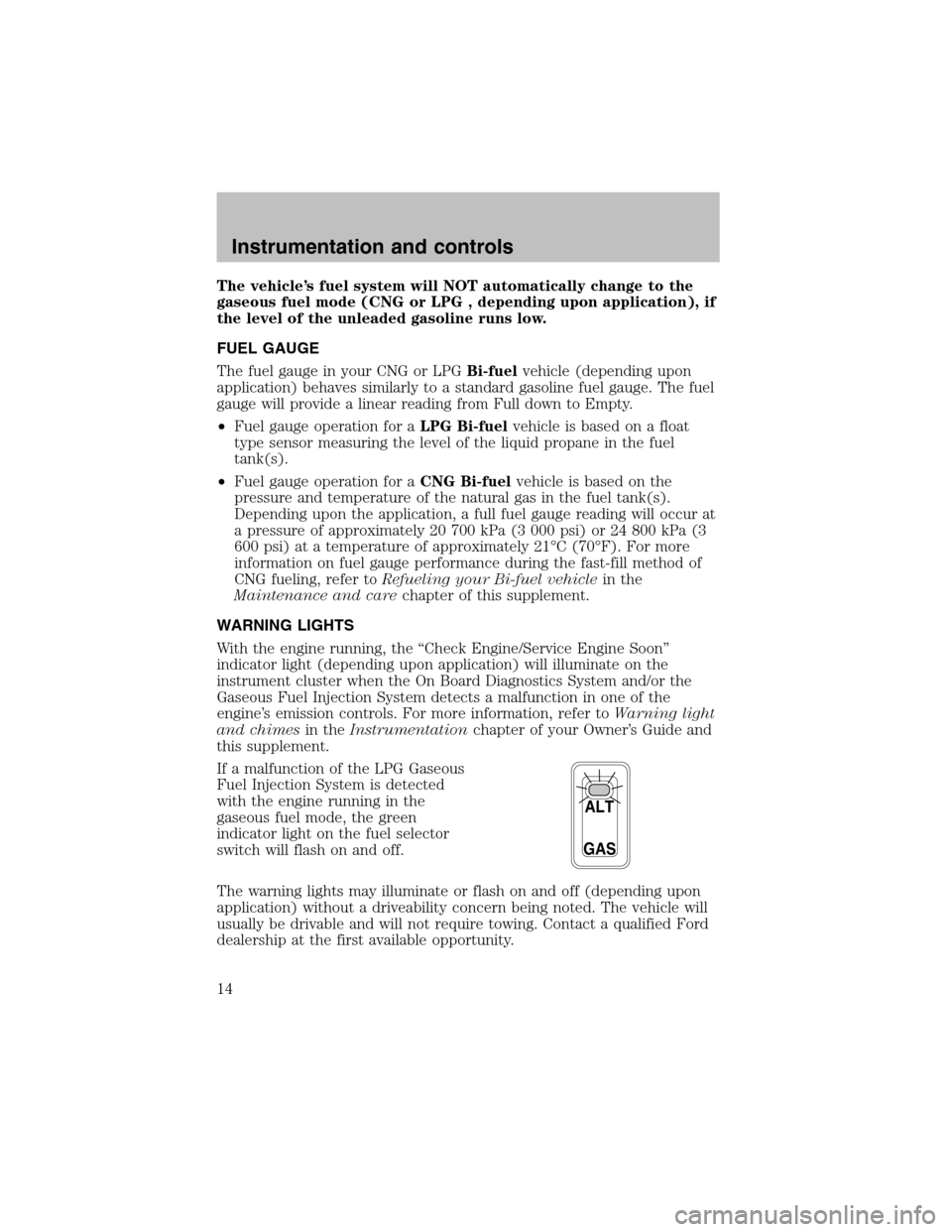
The vehicle’s fuel system will NOT automatically change to the
gaseous fuel mode (CNG or LPG , depending upon application), if
the level of the unleaded gasoline runs low.
FUEL GAUGE
The fuel gauge in your CNG or LPGBi-fuelvehicle (depending upon
application) behaves similarly to a standard gasoline fuel gauge. The fuel
gauge will provide a linear reading from Full down to Empty.
•Fuel gauge operation for aLPG Bi-fuelvehicle is based on a float
type sensor measuring the level of the liquid propane in the fuel
tank(s).
•Fuel gauge operation for aCNG Bi-fuelvehicle is based on the
pressure and temperature of the natural gas in the fuel tank(s).
Depending upon the application, a full fuel gauge reading will occur at
a pressure of approximately 20 700 kPa (3 000 psi) or 24 800 kPa (3
600 psi) at a temperature of approximately 21°C (70°F). For more
information on fuel gauge performance during the fast-fill method of
CNG fueling, refer toRefueling your Bi-fuel vehiclein the
Maintenance and carechapter of this supplement.
WARNING LIGHTS
With the engine running, the“Check Engine/Service Engine Soon”
indicator light (depending upon application) will illuminate on the
instrument cluster when the On Board Diagnostics System and/or the
Gaseous Fuel Injection System detects a malfunction in one of the
engine’s emission controls. For more information, refer toWarning light
and chimesin theInstrumentationchapter of your Owner’s Guide and
this supplement.
If a malfunction of the LPG Gaseous
Fuel Injection System is detected
with the engine running in the
gaseous fuel mode, the green
indicator light on the fuel selector
switch will flash on and off.
The warning lights may illuminate or flash on and off (depending upon
application) without a driveability concern being noted. The vehicle will
usually be drivable and will not require towing. Contact a qualified Ford
dealership at the first available opportunity.
GASALT
Instrumentation and controls
14
Page 24 of 72
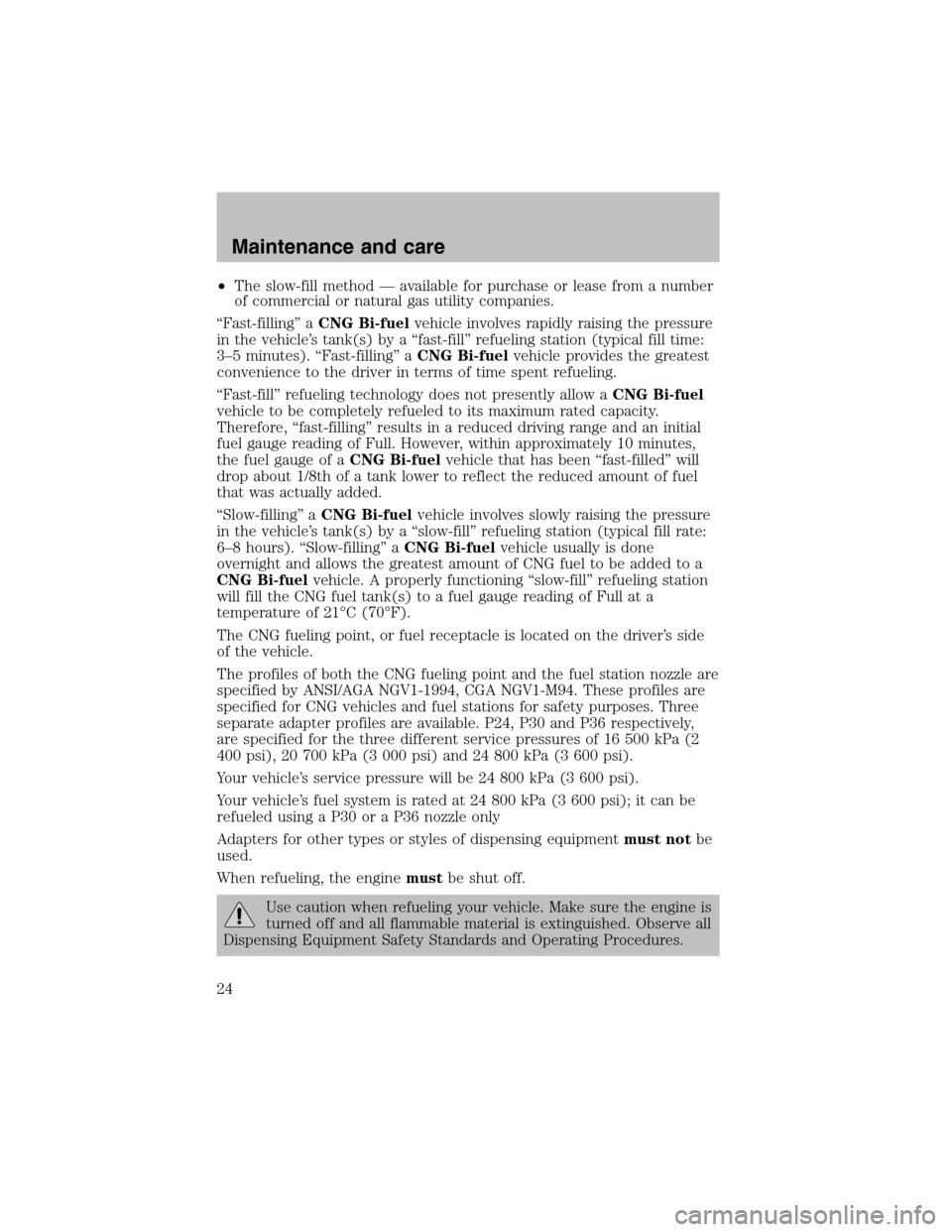
•The slow-fill method—available for purchase or lease from a number
of commercial or natural gas utility companies.
“Fast-filling”aCNG Bi-fuelvehicle involves rapidly raising the pressure
in the vehicle’s tank(s) by a“fast-fill”refueling station (typical fill time:
3–5 minutes).“Fast-filling”aCNG Bi-fuelvehicle provides the greatest
convenience to the driver in terms of time spent refueling.
“Fast-fill”refueling technology does not presently allow aCNG Bi-fuel
vehicle to be completely refueled to its maximum rated capacity.
Therefore,“fast-filling”results in a reduced driving range and an initial
fuel gauge reading of Full. However, within approximately 10 minutes,
the fuel gauge of aCNG Bi-fuelvehicle that has been“fast-filled”will
drop about 1/8th of a tank lower to reflect the reduced amount of fuel
that was actually added.
“Slow-filling”aCNG Bi-fuelvehicle involves slowly raising the pressure
in the vehicle’s tank(s) by a“slow-fill”refueling station (typical fill rate:
6–8 hours).“Slow-filling”aCNG Bi-fuelvehicle usually is done
overnight and allows the greatest amount of CNG fuel to be added to a
CNG Bi-fuelvehicle. A properly functioning“slow-fill”refueling station
will fill the CNG fuel tank(s) to a fuel gauge reading of Full at a
temperature of 21°C (70°F).
The CNG fueling point, or fuel receptacle is located on the driver’s side
of the vehicle.
The profiles of both the CNG fueling point and the fuel station nozzle are
specified by ANSI/AGA NGV1-1994, CGA NGV1-M94. These profiles are
specified for CNG vehicles and fuel stations for safety purposes. Three
separate adapter profiles are available. P24, P30 and P36 respectively,
are specified for the three different service pressures of 16 500 kPa (2
400 psi), 20 700 kPa (3 000 psi) and 24 800 kPa (3 600 psi).
Your vehicle’s service pressure will be 24 800 kPa (3 600 psi).
Your vehicle’s fuel system is rated at 24 800 kPa (3 600 psi); it can be
refueled using a P30 or a P36 nozzle only
Adapters for other types or styles of dispensing equipmentmust notbe
used.
When refueling, the enginemustbe shut off.
Use caution when refueling your vehicle. Make sure the engine is
turned off and all flammable material is extinguished. Observe all
Dispensing Equipment Safety Standards and Operating Procedures.
Maintenance and care
24